Mastering Cloud-Native: A Comprehensive Guide to Building Applications from Scratch
The paradigm shift towards cloud-native application development represents a fundamental evolution in software engineering. Rather than simply hosting traditional applications in the cloud, cloud-native principles embrace the distributed nature and elasticity inherent in modern cloud platforms. This approach is not merely an optimization; it is a strategic imperative for organizations aiming to achieve unparalleled agility, scalability, and resilience. This comprehensive guide will delineate the essential steps and considerations for building a cloud-native application from scratch, leveraging best practices and robust architectural patterns.
Understanding the Cloud-Native Mandate
At its core, a cloud-native application is designed to fully exploit the cloud computing model. This involves a suite of interconnected principles and technologies:
- Microservices: Decomposing large applications into small, independent, loosely coupled services.
- Containerization: Packaging applications and their dependencies into portable, isolated units (e.g., Docker).
- Orchestration: Automating the deployment, scaling, and management of containers (e.g., Kubernetes).
- DevOps and CI/CD: Integrating development and operations for rapid, automated release cycles.
- Observability: Enabling deep insight into application behavior through logging, metrics, and tracing.
- Immutable Infrastructure: Deploying new instances rather than modifying existing ones.
Embracing these tenets allows for faster iteration, improved fault isolation, and efficient resource utilization, crucial elements when building cloud-native apps.
Phase 1: Architectural Foundation and Technology Selection
1. Define Your Microservices Architecture
The initial phase necessitates a meticulous design of your application's boundaries. Instead of a monolithic structure, identify distinct business capabilities that can be encapsulated as independent microservices. Each service should ideally manage its own data store and communicate via well-defined APIs (REST, gRPC, or message queues).
2. Select Your Core Technologies
The choice of technology stack is paramount. Key decisions include:
- Cloud Provider: AWS, Azure, GCP, or a hybrid cloud solution. Evaluate their respective managed services for databases, messaging, and orchestration.
- Container Runtime: Docker remains the de facto standard for container image creation.
- Container Orchestration: Kubernetes is the industry standard for managing containerized workloads at scale. Familiarity with Kubernetes concepts (Pods, Deployments, Services, Ingress) is critical.
- Programming Languages and Frameworks: While polyglot persistence is a benefit of microservices, consider languages and frameworks well-suited for cloud-native development (e.g., Spring Boot for Java, Flask/Django for Python, Node.js for JavaScript, Go).
These foundational choices dictate much of your subsequent development and operational strategies.
Phase 2: Development and Containerization
3. Develop Individual Microservices
Each microservice should be developed as an independent unit. Emphasize clean code, robust error handling, and adherence to API contracts. Best practices dictate that each service should be:
- Stateless: Session state should be externalized to a cache or database.
- Resilient: Implement circuit breakers, retries, and bulkheads to prevent cascading failures.
- Discoverable: Utilize service discovery mechanisms within your orchestration layer.
4. Containerize Your Applications
For each microservice, create optimized Docker images. A well-constructed Dockerfile is crucial for efficiency and security:
- Use minimal base images (e.g., Alpine Linux).
- Layer dependencies effectively to maximize cache utilization.
- Run applications as non-root users.
- Scan images for vulnerabilities.
This containerization strategy for cloud ensures portability and consistency across environments.
Phase 3: Automation and Deployment
5. Implement Continuous Integration and Continuous Delivery (CI/CD)
Automated pipelines are the cornerstone of agile cloud-native development. A robust CI/CD workflow typically involves:
- Version Control: Git (e.g., GitHub, GitLab, Bitbucket) for source code management.
- CI Server: Jenkins, GitLab CI, GitHub Actions, or Azure DevOps for automated builds, tests, and static analysis.
- Container Registry: Docker Hub, Quay.io, or cloud provider registries for storing container images.
- CD Tool: ArgoCD, Spinnaker, or native Kubernetes deployments for automated deployments to various environments (dev, staging, production).
This automation significantly reduces human error and accelerates release cycles.
6. Deploy to Your Cloud Environment
Leverage Kubernetes to deploy your containerized applications. Key considerations include:
- Deployment Strategies: Employ rolling updates, blue/green deployments, or canary releases to minimize downtime and risk during updates.
- Resource Management: Define CPU and memory requests/limits for pods to ensure stable operations.
- Networking: Configure Kubernetes Services and Ingress controllers for internal and external traffic routing.
- Configuration Management: Utilize Kubernetes ConfigMaps and Secrets for environment-specific configurations and sensitive data.
Phase 4: Operational Excellence
7. Establish Comprehensive Observability
Visibility into your distributed system is non-negotiable. Implement a robust observability stack:
- Logging: Centralized log aggregation (e.g., ELK Stack, Grafana Loki) for comprehensive error diagnosis and tracing cloud-native issues.
- Metrics: Time-series databases (e.g., Prometheus) with visualization dashboards (e.g., Grafana) for performance monitoring and alerting.
- Tracing: Distributed tracing tools (e.g., Jaeger, OpenTelemetry) to track requests across multiple microservices.
8. Prioritize Security
Security must be integrated throughout the development lifecycle, not as an afterthought:
- Network Security: Implement network policies, firewalls, and segmentation.
- Identity and Access Management (IAM): Apply the principle of least privilege for all services and users.
- Vulnerability Management: Regularly scan container images and dependencies for known vulnerabilities.
- Runtime Security: Monitor and protect container workloads during execution.
Conclusion
Building a cloud-native application from scratch is a multifaceted endeavor that demands a strategic mindset and a commitment to modern engineering practices. By meticulously designing microservices, leveraging robust containerization and orchestration technologies, automating CI/CD pipelines, and establishing comprehensive observability and security protocols, organizations can unlock the full potential of cloud computing. This iterative journey not only results in more resilient and scalable applications but also fosters a culture of agility and innovation, preparing your enterprise for the future of digital services.




